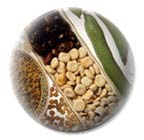- Home
- Introductions

|
Vegetable Seed Production
|
 |
Common Name: Sweet Corn Scientific Name: Zea mays (Saccharata group) Family: Poaceae |
Sweet Corn introduction & history
Corn is a new world crop and was probably domesticated in Tehuacan Valley of southern Mexico a very long time ago. The original plant was a wild, annual grass, perhaps with a terminal flowering structure with male flowers above and female flowers below. Another theory suggests that the original plant may have had a terminal male spikelet with several small female spikelets at the nodes immediately below the male spikelet. Seed bearing spikelets were 19-25 mm (3/4 to 1 in.) long. Lake bottom samples near Mexico City reveal the presence of wild corn pollen that is 60-70,000 years old.
Deliberate cultivation of maize began about 7000 years ago. From the 1 inch (2.5 cm) wild pod, maize has been selected to have a pod many times larger than the wild form. As a basic food plant, maize spread from the northeastern U.S. to southern South America hundreds of years before the arrival of the Europeans. Present forms of maize cannot exist without being cultivated by man. Teosinte (Z. mays spp. mexicana) may be similar to the wild plant from which corn was developed.
Sweet corn occurs because of the recessive su gene, which causes sugar rather than starch to accumulate in the endosperm. This mutation probably arose several times in many areas and was maintained by native peoples. Sweet corn, as well as popcorn, sources in this country were clearly from native Americans. Sweet corn did not become a major food crop in the US and Canada until about 100 years ago. Only recently has sweet corn become popular elsewhere in the world. Sweet corn is generally not consumed by Western Europeans. For example, many Germans refuse to eat sweet corn because they consider it to be "animal feed".
Corn is a monocot.